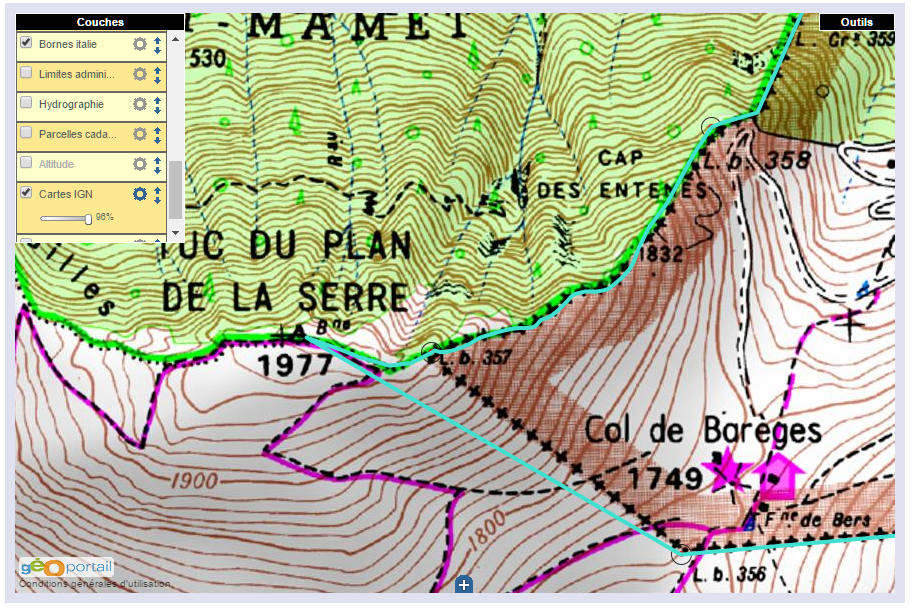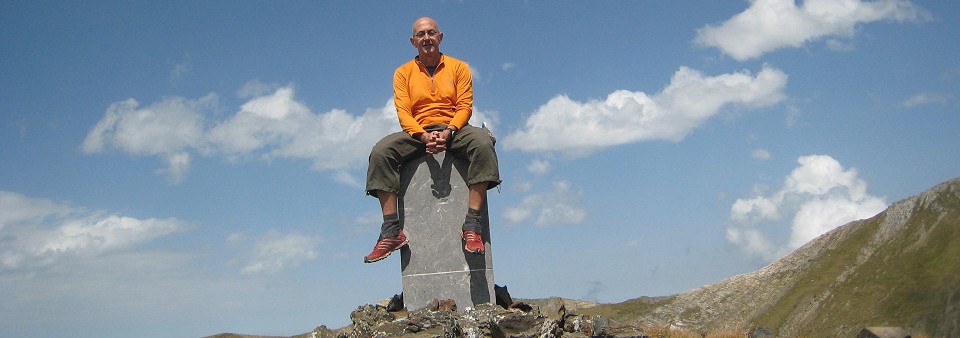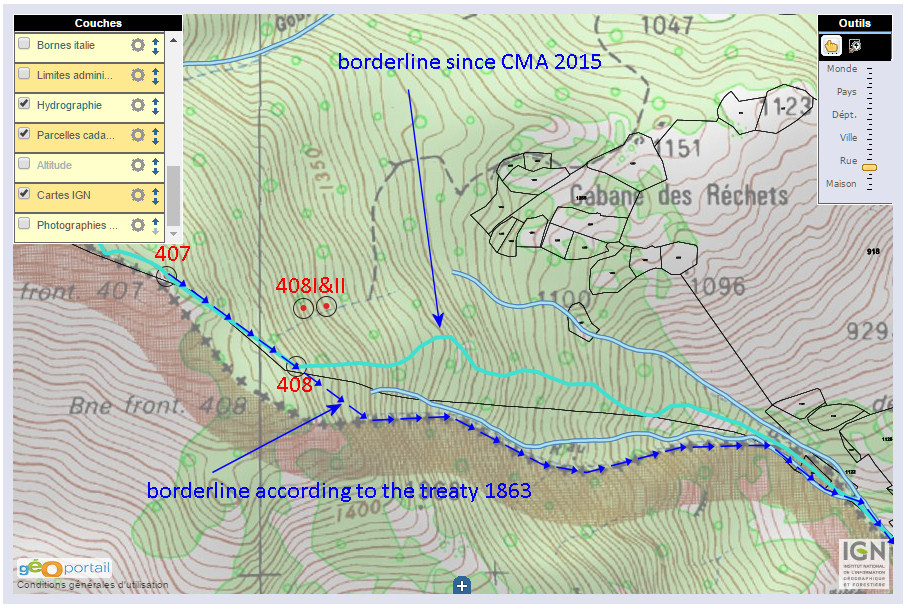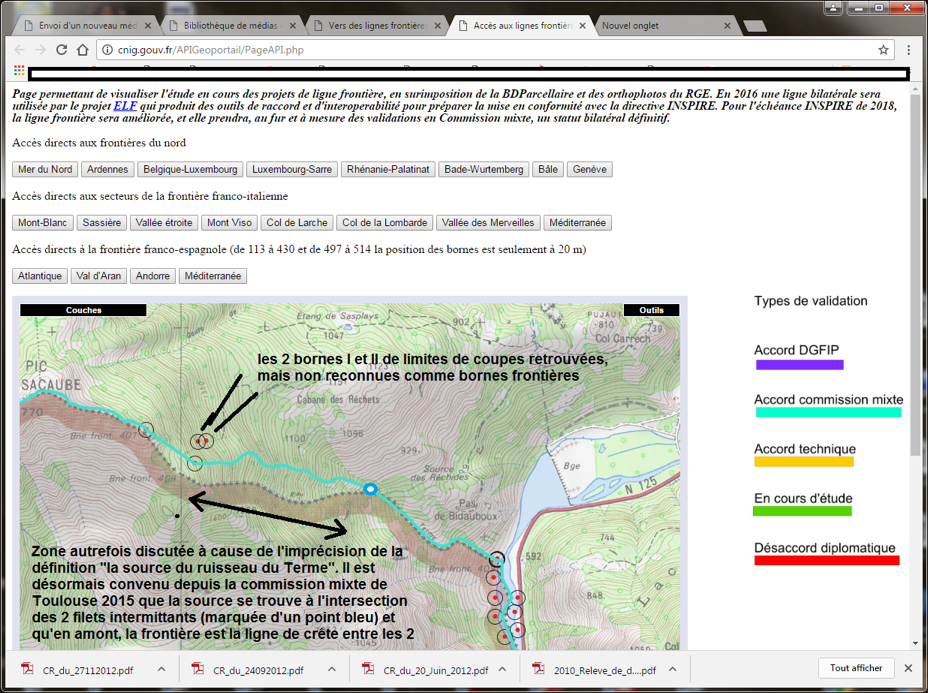Thanks to Michel Molia I discovered something amazing: the borderline between bm356 and 357 and between bm408 and 409 will most probably change.
The INSPIRE-project is a broad international attempt to synchronize geodata in the EU. One part consists of re-measuring and re-establishing the borderlines in bilateral agreement. Narrowing down to the ESFR-border: in 2015 an agreement was reached in the bilateral Commission Mixte d’Abornement in Toulouse.
You can see the result for the Pyrenees on this website showing the map with the borderline agreed-upon and the bordermarkers. The main purpose of the project is explained at this page
and specific to the ESFR-border on this webpage.
We read: “Commission mixte 2015. Une ligne frontière unique, bilatérale et numérique a été validée à la CMA de Toulouse en octobre 2015. Mais elle reste temporaire à proximité des bornes non encore mesurées précisément ainsi que de quelques sites où une mise en évidence contradictoire pourrait être produite.” So the newly measured (digitally) borderline is still provisionary because not all bordermarkers have been precisely measured yet.
There are many details still to study and to discuss here but let’s focus on two very interesting areas
Bm356-357
Last year I launched a new hypothesis how the borderline between bm356 and 357 was wrongly re-established in the 1950-ies (see this page). So I was happily surprised that the new borderline is exact as I thought it was meant in the Treaty of 1862 . Finally justice.

Bm408-409
I was even more surprised – but less happily – by the new borderline on this steep hillside. I have written about its intriguing story on this page. Conclusion then: the treaty leaves no doubt about the right borderline, the placement of four submarkers by Jean Sermet around 1965 served a diplomatic purpose but changed the borderline wrongly. Problem: no one knows nowadays where that new borderline was because 2 of the 4 submarkers are unfindable.
The CMA has aborted the borderline of Jean Sermet but has now its own diplomatic version somewhere in between the (supposed) Sermet-line and the Treaty-line. But it still violates the Treaty! In this case: justice needs to be done yet.
To finish: the map which Michel Molia received from the IGN when he asked for information with some explanation by some IGN-official.
The explanation (added in black on the map) says that the Treaty was inprecise about where the source of the Ruisseau du Terme was. As said that is not true: in my opinion the text of the Treaty leaves no doubt about the course of the borderline.



Interesting…of course one of the ironies is that the greater the technical specificity by which the border may be found…the less important it is! A few meters here and there between two EU countries in otherwise inaccessible terrain would seem of little consequence–except of course to you and I and those few people for whom borders are of inherent fascination.. It’s not like Baarle-Hartog, where tourists can line up at cafes for photographs!
As always, your posts fascinate me..All the best for the New Year.
David de Oregon.
Estupendos comentarios.
Bravo!!!!
Hello, Eef,
About Bm356-357, I remind you that Jean Sermet confirmed the correct situation of bm357, from bm356 and 358.
“…The position of the bm357 is for sure exact. As it is not only defined by the 710 meters which separate her straight from the bm356 (this one indubitable in situation) but also defined by the 602 meters which by the crest separate her from the bm358 of the Cap des Entenés, cap which according to the 1863 writings is reported as immediately close to the precipice on the Artiguette. Yet there was no error for the Cap des Entenés and all the less since we found the base of the former bm358 as of 1863.” Pyrenees n°131 – JUL-SEP 1982 p 238. (1)
For Bm408-409, contrary to what you wrote, I don’t think Jean Sermet “changed the borderline wrongly“. The land is hard and difficult and offers no economic interest to any of the two countries. He wrote in 1962: ″…On the spot, none of the two frontier commissions that dealt with the dispute was able to make a really exact report of the ravine that could mark the border. The one on the southern side is in fact the deepest, but the one northern has more water. The topographic thesis supported by the French administration was opposed by the hydrographic thesis of the Spanish side.” (2)
You then write: ″Problem: no one knows nowadays where that new borderline was because 2 of the 4 submarkers are unfindable″.
In the letter sent by the Prefect of the Haute-Garonne as of 28/01/1972 to the Minister of the Interior, we learn that “…the materialization of the frontier between the bm408 and bm409 was ordered by the Commission of the Pyrenees and executed in 1969. A topographic plan of this sector was drawn up with indications of intercalary markers and in 1970, it was presented to the first Sub-Commission of the Commission of the Pyrenees, which acknowledged it. The work is made thus there.” (3)
During a 1962 session, the International Commission of the Pyrenees “…chose to fix the international demarcation to the most northerly placed brook. So that there is not error in the future anymore, she requested the course of this delimitating brook to be marked out by four small markers built since its beginning ” slightly in the South of the bm408 ” (text of the Convention) up to the bm409 at the precise location where the Arroyo del Termino joins the Garonne”. (4)
As for the map received by Michel Molia, it is written: “found the 2 markers I and II for the limits of cutting but not recognized as boundary markers” (5). These markers are not markers of cuttings but indeed they are official intermediate markers (See above).
Then: “Location used to be subject to controversy/discussion because of the lack of precision in the definition for “the brook beginning of the Term”. Since the Joint Commission of Toulouse in 2015 it is now agreed that the brook spring is the intersection of 2 intermittent nets (marked with a blue point) and that, upstream, the border is the crest line between 2.” (6)
Between the bm408 and the intersection, there are woods and forests and the landscape is irregular: it is therefore difficult to determine the crest lines from one another.
You write: “the text of the Treaty leaves no doubt about the course of the borderline”. I believe that back then and until 1959, the land was deforested. Making it easy to draw the border and later to build submarkers (J. Sermet, 1962: “The wood having been cleared, one can have from now a better idea of the topography.”) (7)
However, as reports David de Oregon, ″A few meters here and there between two EU countries in otherwise inaccessible terrain would seem of little consequence″.
Friendships.
(1) “…La position de la borne 357 est certainement correcte. Car elle est déterminée non seulement par les 710 mètres qui la séparent en droite ligne de la borne 356 (celle-ci indubitable en situation) mais encore par les 602 mètres qui par la crête la séparent de la borne 358 du Cap des Entenés, que le texte de 1863 dit immédiatement proche du précipice sur l’Artiguette. Or il n’y avait pas d’erreur pour le Cap des Entenés et d’autant moins que l’on y retrouva la base de l’ancienne borne 358 de 1863.” Pyrénées n°131 – JUIL-SEP 1982 p 238.
(2) “…Sur place, les deux commissions frontalières saisies du litige ne purent se rendre un compte véritablement exact du ravin le plus susceptible de marquer la frontière. Celui du Sud est effectivement le plus profond, mais celui du Nord a davantage d’eau. Une thèse topographique soutenue par l’administration française s’opposait à une thèse hydrographique soutenue du côté espagnol.” (J. Sermet : Problèmes de frontière près le Pont du Roy-Bidaoubous-Ruisseau du Terme).
(3) “…la matérialisation de la frontière a été ordonnée par la Commission des Pyrénées entre les bornes 408 et 409, et réalisée en 1969. Un plan topographique de ce secteur a été dressé avec indication des bornes intercalaires et montré en 1970 à la première Sous-Commission de la Commission des Pyrénées, qui en a pris acte. Le travail est donc là effectué.” (Lettre du Préfet de la Haute-Garonne du 28/01/1972 au Ministre de l’Intérieur).
(4) La Commission Internationale des Pyrénées, lors de sa session de 1962 “…choisit de fixer la démarcation internationale sur le ruisseau situé le plus au Nord. Pour qu’il n’y ait plus de méprise ultérieure, elle demanda que le cours de ce ruisseau délimitateur soit jalonné de quatre petites bornes bâties depuis sa naissance “légèrement au sud de la borne 408″ (texte de la Convention) jusqu’à la borne 409 au point même où l’Arroyo del Termino rejoint la Garonne…”
(5) “les 2 bornes I et II de limites de coupes retrouvées, mais non reconnues comme bornes frontières.”
(6) “Zone autrefois discutée à cause de l’imprécision de la définition “la source du ruisseau du Terme”. Il est désormais convenu depuis la commission mixte de Toulouse 2015 que la source se trouve à l’intersection des 2 filets intermittents (marquée d’un point bleu) et qu’en amont, la frontière est la ligne de crête entre les 2.”
(7) “Le bois étant éclairci, on peut se rendre désormais un meilleur compte de la topographie.” (J. Sermet : Problèmes de frontière près le Pont du Roy-Bidaoubous-Ruisseau du Terme).